
Month long budget project for students. Instructions and template included.
- Subject:
- Career and Technical Education
- Material Type:
- Activity/Lab
- Rubric/Scoring Guide
- Date Added:
- 06/19/2018

Month long budget project for students. Instructions and template included.
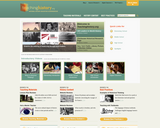
Teachinghistory.org (National History Education Clearinghouse) offers resources to teachers in multiple ways. Three sections outline teaching materials, history content, and best practices in teaching history. There are links for elementary, middle, and high school teachers, with everything from complete lesson plans to general outlines of historical events and skills. You can also access research on the state of history education in the country, as well as a blog and the teachinghistory.org community.

Students will use a pully system (one provided by teacher or created from VEX equipment if have it available) to measure components and identify relationships between the three components of Newton's 2nd Law (force, mass, acceleration). In this lesson, students will change either mass or force to calculate acceleration of a cart over a specific distance. Students will be able to identify the relationship between force and acceleration for Part A of the activity and then the relationship between mass and acceleration for Part B. In Part A of the activity, students will change the force pulling on the cart and keep the mass of the cart the same to calculate acceleration. In Part B of the activity, students will change the mass of the cart and keep the pulling force the same to calculate acceleration. Students will gather their data and constuct a graph representing the data gathered and identifying the relationship between acceleration and mass or force. I have added the component that once all data is gathered from the experiment, students will write and document their results in a full lab report.
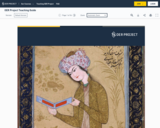
This teaching guide from the OER Project outlines their courses, PD, and other resources.
The OER Project is a coalition of educators and historians committed to boosting student engagement and achievement through transformational social studies programs. By empowering classroom teachers with better curricula, content, and a vibrant community, we deliver more compelling, impactful, and usable histories. “OER” stands for open educational resources. When you grab a free worksheet off Pinterest for your tenth graders, that’s an OER resource. We recognize the value of OER resources, but want to go beyond the typical content repository approach—we aim to improve OER by providing coherency, support, and community.
Currently, the OER Project offers two courses—Big History Project (BHP) and World History Project (WHP)—both of which are completely free, online, and adaptable to different standards and classroom needs. Unlike textbooks, lesson websites, and other commercial products, everything has been purposely built to truly empower teachers and leave traditional history courses in—sorry for the pun—the past. We also offer short, standalone courses for those who want to try the OER Project approach, but aren’t yet ready to take on a full history course. Our current standalone options include Project X, a course that uses data to explore historical trends to help make predictions about the future; Project Score, a course that uses writing tools and the use of Score, a free, online essay-scoring service to help support student writing; and Climate Project, an evidence-based overview of the global carbon problem that culminates in students developing a plan of action they can implement locally
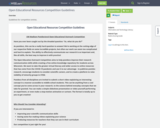
Guidelines for competition entries.
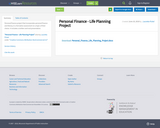
Personal finance project that incorporates personal finance and literacy in a formative assessment on a topic of their choice. It includes a written and oral presentation.
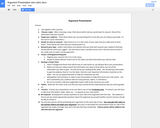
This may be used as a way of having students present in a persuasive, true-to-life format. It can be used as a business education/marketing format, as well as a way of having students persuade an audience through both speaking and using visual aids.

In this project, students will design and construct a roller coaster. The materials used in this activity can be found materials (pipe insulation, paper tube, wood dowels, etc. for little or no cost.
For a small fee, Paper Templates for a Paper Roller Coaster can be purchased from paperrollercoasters.com. This kit includes one set of detailed directions with over ninety color photographs, and eleven templates suitable for photocopying. Each set of paper templates may be used for one home or classroom only. You supply card stock, marbles, tape, and a piece of cardboard.
Once constructed the coasters are constructed, students will analyze the physics of motion of a roller coaster car and its occupants in terms of concepts such as speed, acceleration, Newton’s Laws, net forces, normal forces, friction forces, and energy (KE, PE, TME); this description should be both mathematical and conceptual.
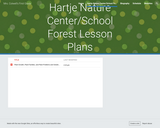
Students will compare and contrast adult plants and seedlings/young plants using pictures, journaling, growing plants in the classroom and comparing experimental plant growth with natural plant growth to learn why plants survive and where.
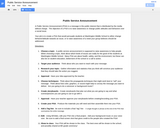
This is a project that can be used individually or with groups. It includes detailed instructions and rubric.
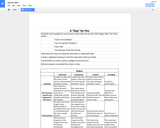
This is a student activity that has groups or individual students creating a music video around an Edgar Allan Poe story. They need to read a short story by Poe, summarize it in lyric form and then create a music video on WiVideo. The grading rubric is included with the assignment as well as story suggestions.
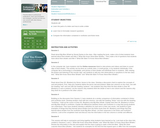
This series of eight lessons has students compare information found in fiction and non-fiction texts related to whales. Students learn to formulate research questions, interact with an online scientist and write letters using the writing process.

This comprehensive lesson plan taps on students' conceptual understanding of the area model, order of operations, and whole-number exponents to explore and solve a card-matching task. Students will need to match a set of compound rectangles to numerical expression that will give the area for the figure. Students will need to utilize the distributive and commutative properties to solve the task. Aside from the expressions and equations standard, this resource can be used as a geometry/measurement task as well. This lesson plan contemplates individual and group activities producing student engagement.
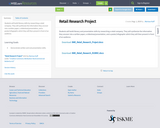
Students will build literacy skills by researching a retail company. They will synthesize the information they uncover into a written paper, a slideshow/presentation, and a poster/infographic which they will then present in front of an audience.

Over the course of the semester students will create, maintain, and compare a nature journal and digital science notebook. The intent of this activity is for them to become familiar with how journals/notebooks can be used by learners to facilitate scientific inquiry endeavors from both nature-based and technology-based perspectives.

Business Applications and Digital Literacy course FREE teacher resources and trial access to online course solution as well as a correlation to WI state BIT standards for business applications. Resources mapped to MOS certification.

Over the past 4 years, Hartford Union High School has been working on a curriculum review process to improve secondary mathematics instruction and achievement. Illustrative Mathematics was selected and adopted for the 2021-2022 school year. Teachers participated in summer IM Teach and Learn training as well as Unit Overviews provided by the Math Institute of Wisconsin. Teacher's also participated in an IM PLC session, Unit Planning, and a book study.The following modules contain samples and templates of documents that were used to facilitate the adoption including teacher and student surveys, the IM Implementation Rubric, Unit Planning, and book study guides.Hartford Union High School Curriclum Adoption TeamDustin Burg, Hartford Union High School Math Teacher (Algebra 2 Lead Teacher)Kaite Burns, Hartford Union High School Math Teacher (Geometry Lead Teacher)Kelly Lam, Hartford Union High School PrincipalMike McIntyre, Director of Curriculum and InstructionMallory Smith, Instructional CoachBob Sliwinski, Hartford Union High School Math Teacher (Algebra 1 Lead Teacher)
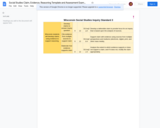
Assessment template to guide students in a standards-based grading classroom on Social Studies Standard 3: CER.
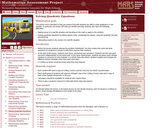
This lesson unit is intended to help you assess how well students are able to solve quadratics in one variable. In particular, the lesson will help you identify and help students who have the following difficulties:
Making sense of a real life situation and deciding on the math to apply to the problem.Solving quadratic equations by taking square roots, completing the square, using the quadratic formula, and factoring.Interpreting results in the context of a real life situation.
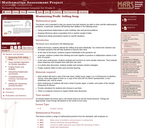
This lesson unit is intended to help you assess how well students are able to solve real-life mathematical problems. In particular, students will develop their abilities in the following areas:
- Using proportional relationships to solve multistep ratio and percent problems.
- Drawing inferences about a population from a random sample of data.
- Making and stating assumptions based on real-life situations.
The lesson unit is structured in the following way:
- Before the lesson, students attempt the Selling Soup task individually. You review their solutions and formulate questions that will help students to improve their work.
- At the start of the lesson, students respond individually to the questions set.
- In groups, students combine their thinking and work together to produce a collaborative solution in the form of a poster.
- In the same small groups, students evaluate and comment on some sample responses. They evaluate these responses and compare them with their own work.
- In a whole-class discussion, students explain and compare solution strategies.
- Finally, students reflect on their work and their learning.